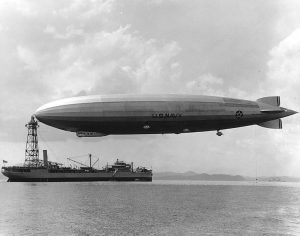New open-source imagery has revealed a giant new hangar at a secretive airfield in the western reaches of China. Although there are no further publicly available details about what kind of vehicle will call the hangar home, its giant dimensions seem to strongly suggest a lighter-than-air craft of some type.
That might suggest that lighter-than-air craft – rigid-framed dirigibles, soft-sided blimps, and hybrid airships, which combine lifting gas with a lifting-body shape – are on the verge of a comeback. But any article about the prospects for a new golden age of airships needs to carry a substantial caveat: Not only have we been here before, but we seem to come back to this space every few years.
Airships are, after all, captivating. They were the first strategic bombers, and made an enormous impression. The images of German aircraft looming over London traumatized and captivated a generation – even if their strategic impact was limited and they proved hopelessly vulnerable to even rudimentary air defenses. That didn’t stop interwar powers from experimenting with airships as for long-range passenger travel, military reconnaissance, and even as flying aircraft carriers. But a series of catastrophic accidents – culminating with the iconic, fiery end of the Hindenberg – put an end to the era of giant, rigid airships right before the outbreak of World War II.
Since then, airships have occupied only a few niche roles. Smaller, frameless blimps played a low-key but successful role as convoy escorts and antisubmarine craft for the U.S. Navy in WWII, while unmanned barrage balloons held steel wires aloft to deter strafing attacks. After the war, a small number of blimps have been used as advertising and camera platforms – roles that are increasingly being taken over by drones.
Nevertheless, the theoretical advantages of airships (along with their apparent cultural cachet) have led to a cottage industry of airship revivalists. Lighter-than-air craft have, at various points, been proposed as heavy-lift aircraft, flying cruise ships, radar stations, communications relays, and even – fantastical as it might seem – as a means of lifting people and cargo into space.
But the contemporary airship revival has been marred by repeated accidents, though admittedly none nearly as catastrophic as the series of total losses that plagued dirigibles through the 1920s and 1930s. Those early accidents also seem to have cemented a public impression that airships are fundamentally dangerous and flawed technology. To be sure, the technology has hard limitations. No one is proposing reviving the Zeppelin strategic bomber concept, even if U.S. nuclear strategists during the Cold War did briefly imagine the idea of basing intercontinental ballistic missiles aboard airships.
That said, there are real technical obstacles still to be overcome. The ongoing supply of helium is far from assured, which both raises costs and makes production and operation of lighter-than-air craft complicated and unpredictable. The alternative lifting gas, hydrogen, is of course highly flammable, a problem that would be extremely difficult if not impossible to engineer away.
Of course, if the airship in question isn’t carrying human beings, it obviates many of the safety concerns – and opens up all kinds of novel form factors, including airships designed to ascend to the edge of space and remain there for weeks at a time. But instead of thinking huge, airship designers should also be exploring the possibilities of going small.
After all, very small UAVs – which are, as we all know, rapidly proliferating – have largely coalesced around vertical takeoff, multi-rotor designs. Those designs tend to have good stability and maneuverability for their size, but suffer from limited loiter time, since their engines are constantly straining against gravity to keep them aloft. A very small airship, on the other hand, would be able to stay in one place for a much longer period, which could be highly advantageous for reconnaissance, communications, and other tasks. It might be more visible, and more susceptible to inclement weather and high winds, but there are numerous tasks where the benefits of a stable platform with very long endurance would outweigh those drawbacks.
And perhaps once people get used to seeing small airships going about tasks safely, the reluctance to trust their larger cousins would diminish. If the goal is to bring about a new age of lighter-than-air travel, perhaps designers should be starting small rather than trying, yet again, to go big.

































